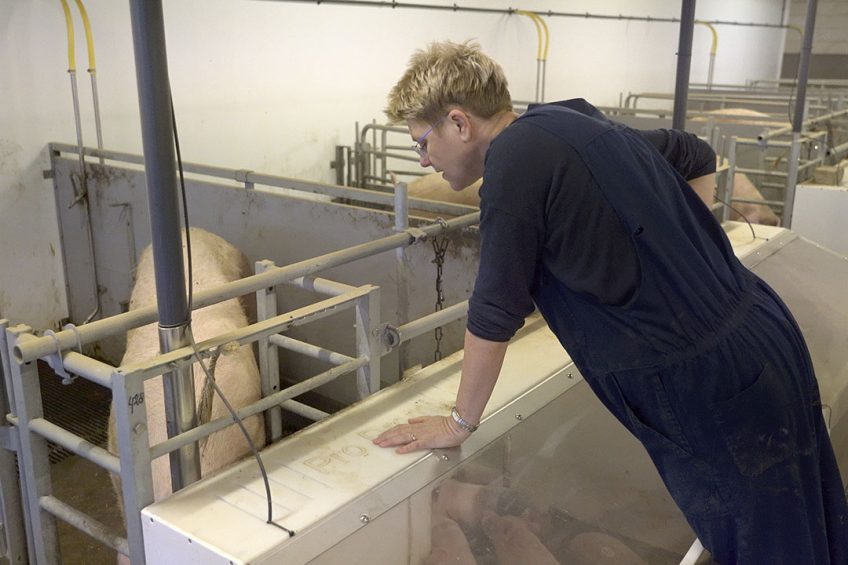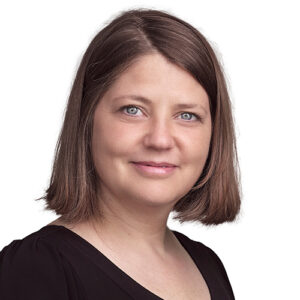Reducing piglet mortality in free farrowing systems

Free farrowing is a tendency that is growing in Scandinavian and Western European countries. Yet, it hasn’t really broken through on a large scale. Part of that is related to mortality figures amongst young piglets. So, how far along is the development of free farrowing systems and what can be expected in the future?
When renowned pig farmer Annechien Ten Have first tested free farrowing on her 600-sow farm in Beerta, The Netherlands, she was a true pioneer in her field. There was no handbook or how-to on the type of management needed to keep her sows and their piglets healthy in a crate-free system. She had to learn it all on her own. Today, she is not alone. The number of pig farmers making the switch to free farrowing is in constant growth. For those making that transition, thankfully there’s plenty of research to support management decisions and new pen design.
When Ten Have decided to make the transition to free farrowing in 2014, she had already done some research by testing out two pens on farm. “We wanted to make a distinguished new market concept,” she said. “And in that, we didn’t want to have discussions on animal welfare.”
In The Netherlands the ‘Beter Leven Keurmerk’ labelling scheme tells consumers how animals were raised and under what specific conditions. Products are labelled with one to three stars, depending on the type of system the animals are raised in. The Dutch Society for the Protection of Animals created the system, which is now widely accepted by consumers. “We are in the two-star scheme,” said Ten Have. “We are the only farmer in The Netherlands that is in that scheme. We also participated because we want a better life for pigs.”
Ten Have admits there were a lot of challenges in the beginning. The sows were not used to the free farrowing system, and neither was she. “Although we had experience with two pens, having 80 pens was a different thing,” she said. “There was a lack of practical management information.”

But the benefits of switching to free farrowing were quickly apparent. The system provides a better life for both sows and piglets, said Ten Have, as the sow is able to exhibit her natural behaviour, and she and her piglets have more contact, which makes her more relaxed. Birthing, said Ten Have, is easier and the piglets are larger come weaning.
A new look at farm management
But managing sows in a free-farrowing system is much different than managing sows in farrowing crates. Barn design and layout is different too. Managers will need to reconsider flooring, climate control and ventilation. While the free farrowing system is a good fit for Ten Have, she still faces challenges. Piglet mortality, for one, is still a big challenge. And while farmers benefit from the knowledge gained by early adopters like Ten Have, some questions, especially those around piglet mortality, are tougher to answer. This is where research comes in.
Researchers like Vivi Aarestrup Moustsen at the SEGES Danish Pig Research Centre (PRC) have been working on the development of housing for lactating sows for over 10 years now. In all Danish herds, sows are kept loose in gestating facilities and also in mating/gestating facilities, but the farrowing and lactation units are still a work in progress, she admitted. Piglet mortality is always an issue and higher in loose housing. “From a piglet welfare point of view, it’s not a positive thing that mortality increases with the sows loose,” she said.

The positives outweigh the negatives, though, in terms of quality of life for both sows and piglets. Piglets, said Ms Moustsen, have better access to the udder when sows are loose. Milk letdown is better in loose sows than in those confined in traditional farrowing crates, and milk letdown is longer in loose sows as well. Sows prefer loose housing, too, as they can better express their natural behaviour, said Ms Moustsen, reiterating Ten Have’s conclusion.
Research at PRC is focused on pen design. In their quest for the perfect pen, Ms Moustsen and the team – in collaboration with Danish and international partners, assessed the needs of sows, piglets and staff. They looked at what the sow does when she first enters the farrowing pen, and what she does while in the pen. She needs a place to lie down and build a nest, and a place to feed, drink, defecate and urinate. Piglets need a warm, dry climate, and they need access to the udder to get colostrum and milk. Workers need to be able to work in a safe environment, and they need easy access to sows and piglets.
Designing the perfect pen
Putting together all of these requirements, the researchers came up with a pen design that they believed was functional for all parties. “But when we took it out to production herds, we noticed that there was higher mortality compared to the farrowing crates,” said Ms Moustsen. To address this issue, PRC joined forces with the University of Copenhagen to evaluate piglet mortality when movement is limited in the first few days. They measured oxytocin in sow saliva, piglet mortality, and changes in sow behaviour.
The first thing they noted was that the sow was nursing or lying down 95% of the time during the first few days after farrowing. Saliva cortisol was not higher for the confined sows compared to the loose sows in the same pen system, but piglet mortality lowered substantially when sows were confined for the first 4 days.
In an effort to balance sow welfare and piglet welfare, the majority PRC’s work focuses on pen design where sows are confined for the first few days to increase piglet survival. For the rest of the lactation period, the sow is loose housed. One aspect they’re looking at is floor design. “It was important to us that we have a solid floor that is dry and clean both for the health and welfare of the pigs and sow, but also so we don’t have ammonia emission problems,” said Ms Moustsen.
In their design, pen size was also increased for piglets because research shows they also need space. “We need the same amount of space for the piglets regardless of the sow being confined or loose,” she said. “We are making larger pens, but that’s to meet the number being born.”
The cost of the pen is another issue their research is addressing. It is very difficult to get consumers to pay more for pork. While the change is big for farmers, it’s not big enough to get consumers to pay a significant premium. “If we cannot do it in a way that is competitive to the crate system, we won’t have pigs in Denmark,” said Ms Moustsen. “If you don’t make pens that are competitive, the farmers cannot afford to use the system.”
In another project, researchers at PRC evaluated 10 farrowing pens for loose-housed sows. The project was conducted partly in response to the Declaration of Intent made at the Animal Welfare Summit in 2014 where the pig industry set the target that 10% of all sows must be loose housed during lactation by 2020/2021. The test was conducted on a commercial farm with approximately 1,000 sows. Researchers rated the following parameters:
- Working conditions during transfer of sows to the pens, and gate function
- The sow’s ability to manoeuvre when confined and when loose, including assistance during farrowing
- Sows and piglets with knee injuries
- Dispersal of feed for sow and pigs, including hygiene in the creep
- Piglets use of the creep area
- Working conditions during weaning of sow and piglets
- Working conditions in general and staff safety
- Cleanliness and hygiene in the pen.
While none of the 10 pens scored ‘good’ or ‘very good’ in all parameters, the results confirmed that further development and testing is necessary to produce a robust farrowing pen for loose-house sows.
Equipment manufacturers’ developments
Big Dutchman was part of InnoPig, a project in Germany that evaluated pen design without fixation during birth. “We found out that piglet losses are more or less 10% higher on average – sometimes a little bit more – than conventional farrowing systems,” said Dr Birgit Hinrichs, Product Manager at Big Dutchman. “Another study shows that the number of piglet losses could be reduced if sows are fixed for five days after giving birth.”
In response to these results, Big Dutchman began to offer free farrowing pens with the option to confine the sow short-term. ActiWel is an easy-to-open, versatile farrowing crate that gives the sow more space to move, but functions more like a standard farrowing crate during birth and the first days after birth. The pen was designed with the employer in mind, said Dr Hinrichs, pointing to features that make their model easy to open and close.
Similarly, ACO Funki offers the WelSafe model, which also meets the design recommendations of Ms Moustsen and her colleagues. Torben Olesen, ACO Funki Sales and Marketing Manager, describes it as a square box with a corner trough, which gives the sow the best use of space without using too many square meters in the barn. Laws on space requirements differ from country to country in Europe, explained Mr Olesen. In Denmark, the law requires enough space for sows to move around, but there is no specific requirement. In Germany, producers are required to give about 6 m2, including the space used for the piglet nest and other spaces where the sow cannot be, depending on the region. With these types of criteria in mind, ACO Funki designed WelSafe. The idea was to give the sow as much space as possible without taking too much room in the stable. One of the most important features of the WelSafe model is the ability to close the farrowing wings for a few days. They can be reopened a few days following farrowing, said Mr Olesen. “Because there you save a lot of piglets,” he said. “If you cannot do that then mortality will be far too high.”
When the sow is giving birth, it is very important that her rear end is facing the walkway so the farmer can see and assist if necessary. The piglet nest is also designed to be close to the walkway. The door is situated next to the nest for easy closing from the walkway. The door also provides protection for the worker. “When you have free farrowing sows you need some protection when you are giving the piglets treatments,” he said. “They can be a little aggressive.” The WelSafe design includes space between the nest and where the sow can walk. This space is adjustable, so it can be made larger or smaller when necessary. The great advantage of the free farrowing crate is that the sow’s stomach functions better when she has a chance to move, said Mr Olesen. She eats more and therefore gives more milk. Higher weaning weights mean stronger piglets, which is beneficial to producers who want to lower antibiotic use, he added.
“We can see weaning weights are sometimes 1 kg more in the same time as compared to a traditional farrowing crate,” said Mr Olesen. “Of course, it will be very positive to have this extra kilo of weaning weight because then you can reduce and maybe avoid totally giving the piglets any type of antibiotic during the growing period. If you want to have this type of production then you need a high weaning weight.”
Back in the Netherlands, Ten Have uses the Pro Dromi Nanny system. In collaboration with researchers at Wageningen University and Pig Innovation Centre Sterksel, 14 farmers developed the system, which is manufactured by Vereijken Hooijer. “We love it as a farmer, and we wouldn’t go back to the old system,” said Ten Have. “But, of course, there are some challenges we face.”






